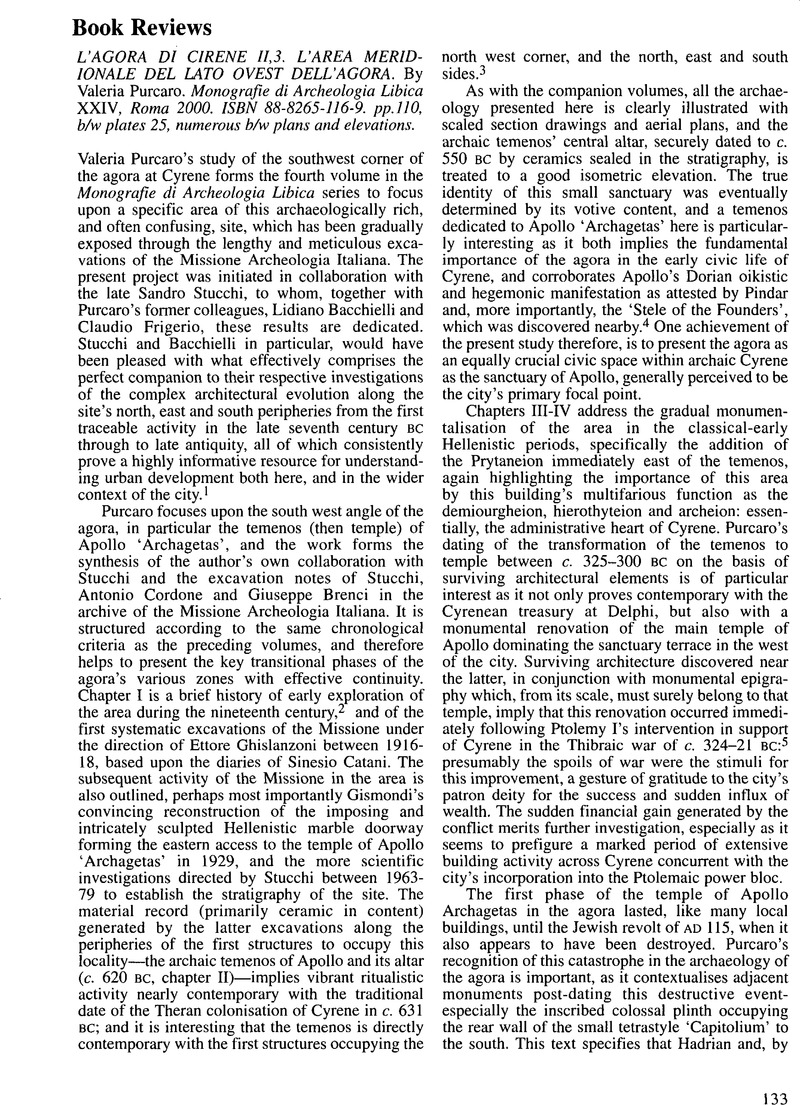No CrossRef data available.
Published online by Cambridge University Press: 03 March 2015

1 Previous monographs on the agora in this series are: Stucchi, S., L'Agora di Cirene I: I Lati Nord ed Est della Platea Inferiore (Monografie di Archeologia Libica VII), Roma (1965)Google Scholar; Bacchielli, L., L'Agora di Cirene II, 1. L'Area Settentrionale del Lato Ovest della Platea Inferiore (Monografie di Archeologia Libica XV), Roma (1981)Google Scholar; Stucchi, S. and Bacchielli, L., L'Agora di Cirene II, 4. Il Lato Sud della Platea Inferiore e il Lato Nord della Terrazza Superiore (Monografie di Archeologia Libica XVII), Roma (1983)Google Scholar; and for the naval monument, Ermeti, A.L., L'Agora di Cirene III, 1. Il Monumento Navale (Monografie di Archeologia Libica XVI), 2 volumes, Roma (1981)Google Scholar.
2 Beechey, F.W. and Beechey, H.W., Proceedings of the Expedition to Explore the Northern Coast of Africa from Tripoly Eastward, in 1821-22, London (1828): 546–8Google Scholar; Smith, R.M. and Porcher, E.A., A History of Recent Discoveries at Cyrene, London (1864): 75Google Scholar (clearance of the tetrastyle temple immediately south of this area in July 1861, now generally interpreted as the ‘Capitolium’); and Camperio, M.Una Gita in Cirenaica, L'Esploratore, Milan (1881–1882): 16Google Scholar.
3 Stucchi op. cit.: 33-49; Bacchielli op. cit.: 21-34; Stucchi and Bacchielli op.cit.: 33-44.
4 Pindar, Pythian Ode V: 60Google Scholar, with the scholiast to V: 4 and IX: 5-8, 13-14, 55 (= Drachmann, A.B., Scholia Vetera in Pindari Carmina II, Stuttgart (1997): 172–3, 220–2, 224–5Google Scholar; for the ‘Stele of the Founders’ see SEG IX: 3, 11, with Meiggs, R. and Lewis, D., A Selection of Greek Historical Inscriptions to the End of the 5th Century B.C., Oxford (1969): 5–9, no. 5Google Scholar. Apollo's founding role for Cyrene is documented in several sources: Rhodios, ApolloniosArgonautika II: 500–16Google Scholar; Callimachos, Hymn to Apollo 91–92Google Scholar; Diodoros Siculos IV: 81.1.
5 The best introduction to this event is Laronde, A., Cyrène et la Libye Hellenistique. Libykai Historial (de l'Epoque Republicaine au Principal d'Auguste), Paris (1987): 41–6Google Scholar; the relevant epigraphy naming strategoi from the period inscribed across a monumental epistyle dedicated to Apollo on the spoils of war discovered re-used in the Roman baths to the immediate east of the temple of Apollo can be found in Oliverio, G., ‘Campagna di Scavi nell'Estate del 1928’, Africa Italiana 3 (1929): 204, nos. 24–6Google Scholar; and Oliverio, G., Pugliese Carattelli, G., and Moretti, G., ‘Supplemento Epigrafico Cirenaico’, Annuario della Scuola Archeologia di Atene 39–40 (1961–1962): 219–376, nos. 132a–b, pp. 294-5Google Scholar. The thesis is recently proposed in Walker, S. and Adams, N., ‘A New Portrait of Berenike II from the Temple of Apollo at Cyrene?’ Quaderni di Archeologia della Libia (in press).
6 SEG IX: 136. Antoninus is named as his adotive son, the adoption occurring on the 25th of February
7 A basic outline of the temple of Aphrodite can be found in Goodchild, R.G., Kyrene und Apollonia, Zurich (1971): 78Google Scholar; Stucchi, S., Architettura Cirenaica, Roma (1975): 54Google Scholar. For its original excavation, Smith and Porcher op. cit.: 76, with a letter of Murdoch Smith to Sir John Burgoyne dated 20th August 1861 in British Museum Central Archive Original Letters and Papers 70: 05-August 1861, 412Google Scholar.
8 Stucchi op. cit.: 293-4; Bacchielli op. cit.: 184-8; Stucchi and Bacchielli op. cit.: 111-3.